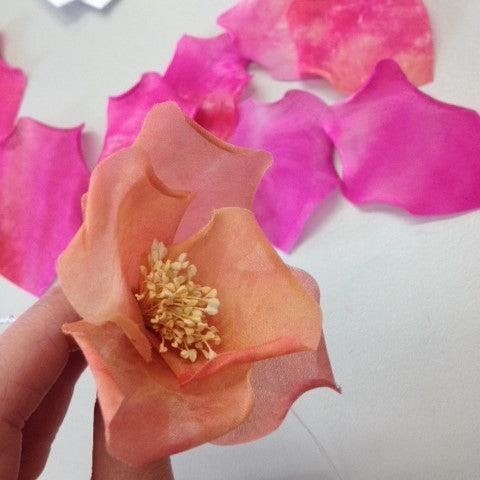As you begin to expand your millinery skills and the different techniques that you apply to your hat-making repertoire, it may be incredibly useful to learn how to make custom dyes and various colors for your clients to enjoy. Famous and experienced milliners will often offer to dye their clients the option of having their handmade headpieces dyed a specific color of their liking, allowing patrons to purchase a hat that will match a particular outfit that they may be wearing to a special event.
Like all millinery methods and techniques, dyeing your handmade hats will take lots of practice, and understanding how to reproduce specific colors will require an undeniable amount of record-keeping for you to remember exactly what you did to create the unique hues pained within your hats. There are several different materials that are within the practice of millinery that can be dyed. To choose the correct dye you need, you must first decide on the specific fiber that you want to dye.
Fiber Reactive Procion Dyes
Fiber reactive procion dye is a durable and wash-safe dye that is best used on materials, such as cotton. A reactive dye basically means that a chemical reaction must occur in order for the dye to set into the fabric, becoming permanent.
Acid Dyes
Acid dyes can be used to dye individual protein fibers, such as silk, feathers, or wool. Acid dyes are mixed with household acid, usually citric acid or vinegar, allowing the dye stain to quickly attach to the material’s fibers. Remember, the acid dye should be handled with a lot of care. You should definitely consider wearing a mask over your eyes and rubber gloves to protect yourself as much as possible when dealing with this kind of dye.
Aniline Dyes
If you are making a hat or a headpiece out of leather, the best dye to work with is aniline dye. These are readily available for you to use and purchase at leather suppliers, such as Leather World. Aniline dyes can be easily diluted with rubbing alcohol and are water-soluble, making them easy to work with when you are constructing a hat out of leather.
How To Get Started With Millinery Dyes
No matter what kind of dye or particular material you are working with, you must gather together some essential tools that will be used within the dying process. Tongs, mixing spoons, old towels, rubber gloves, measuring spoons, aprons, pans, and jars are the household materials that you can gather to use while dyeing your millinery fabrics. You might even want to set aside or isolate certain brushes and containers for specific colors that you are using, in order to prevent contaminating or mixing the different colors together. Before you begin dyeing your materials, make sure that you soak the different fabrics or materials, allowing them to have the ability to easily accept the color that you will be dyeing them.




